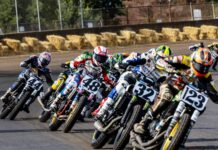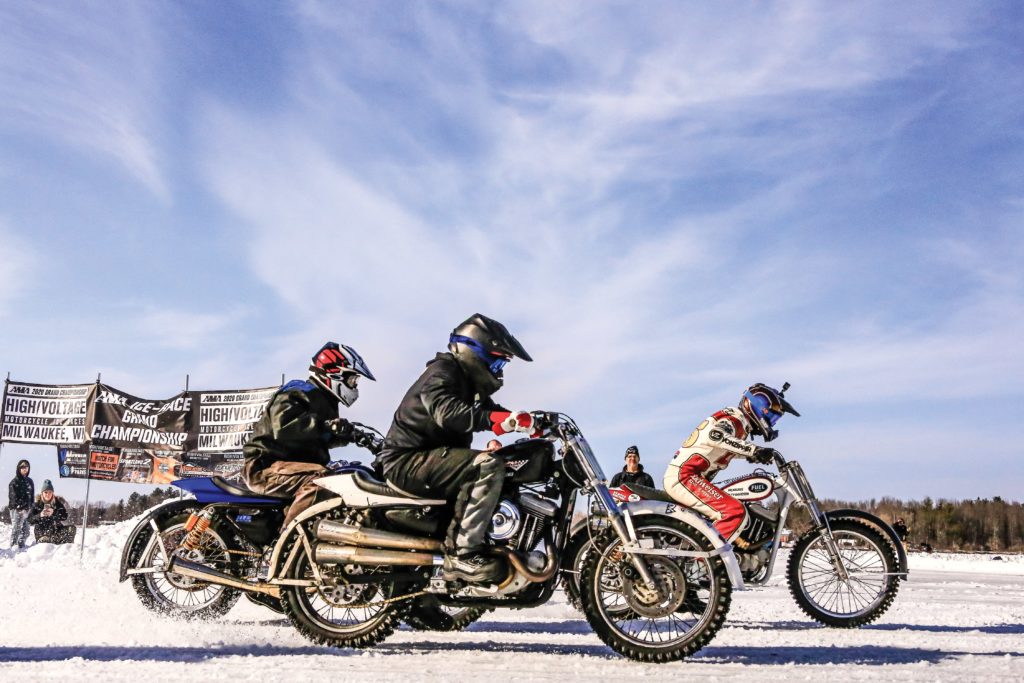
Hijinks, Harleys and High-Voltage V-Twin Racing on a Frozen Wisconsin Lake
Words and photos by Kali Kotoski
About two hours northwest of Milwaukee sits the town of Weyauwega — a sleepy rural hamlet home to a couple of dairy plants, just as many stoplights and a tall Lutheran Church whose roof, in late February, is partially covered in snow.
The church looks down on a frozen lake where, on this day, a four-wheel drive truck surfaces the ice with a large spinning spiked broom, as two other trucks with plows follow behind and push the dustings into a growing snowbank.
It is still morning, but the sun is warm and a dozen kids on 50cc minibikes take a practice run around the oval, heads disappearing behind the snowbank as they lean into turns two and three and pop back up on the straightaway.
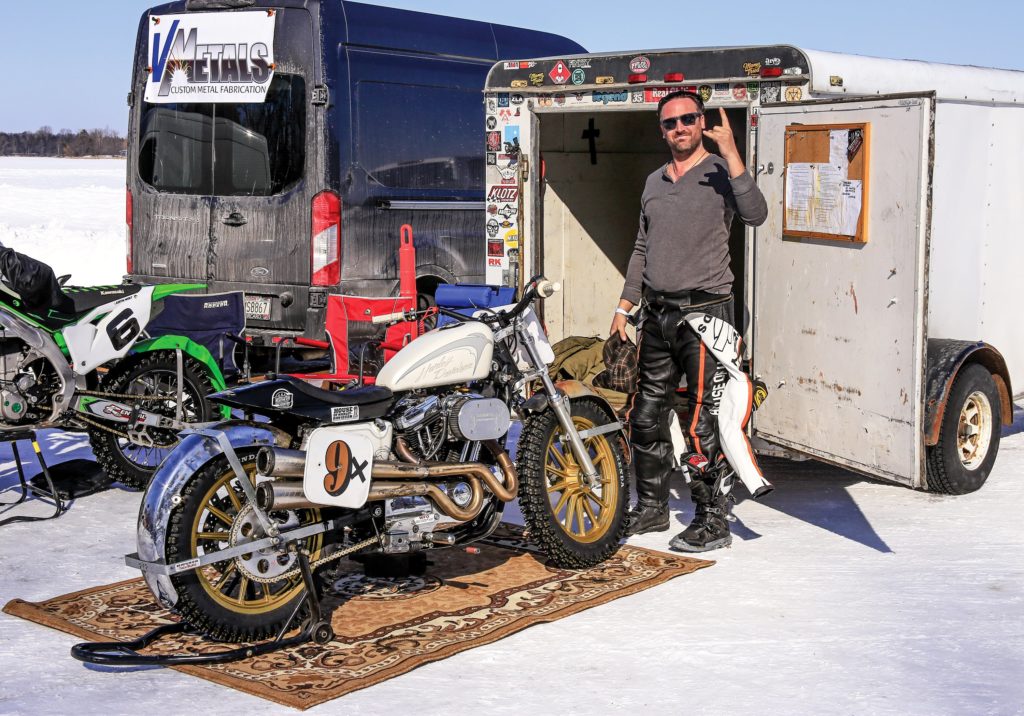
Over 150 motorcycles and just as many trucks and trailers are parked out on the 18 inches of ice — the bikes on box stands as riders wrench on them and inspect their carefully studded tires that look more like chainsaw blades than rubber hoops. The studs, pretty much high-quality sheet metal screws, are dialed in to provide more grip or slip depending on the angle and direction of the slot in the screw head.
The announcer is testing the sound system as Ron Brefka makes his way to the pit with a small entourage in tow. For Brefka, the organizer of the High Voltage Motorcycle Ice Races, it has been a daunting task to get this far.
The last five or six weeks were unseasonably warm, Brefka briefly explained, causing the races to be postponed time and time again.
“And of course, with my luck, and it is exactly my luck if you know me,” he said with a smile, “we got slushed out and melted out, so we had to move four times from Milwaukee’s Wilson park. It was like planning four races, but I wasn’t going to give up.”
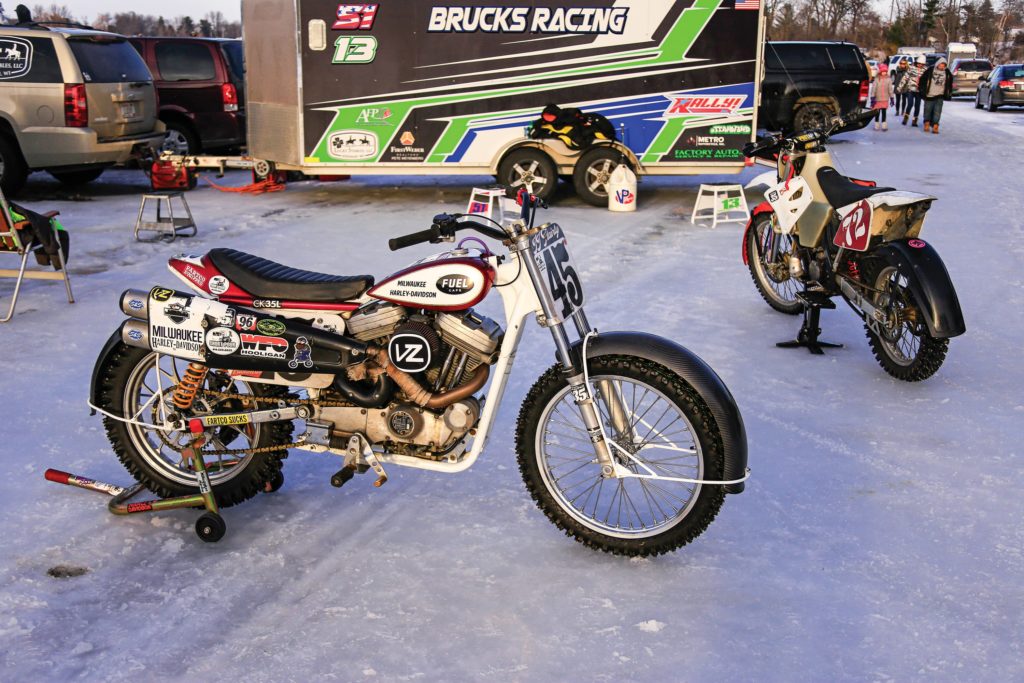
Finding the right ice for motorcycle racing can be difficult. It can’t be too thin, but it also can’t be too rough and jagged from numerous freeze-thaw cycles – especially with some of the Harleys and Indians weighing in at 500-pounds plus.
Brefka was on a mission to make sure everything was good to go, so I told him would find him later after the hooligan class he was racing in completed its practice run.
The air still smelt of winter combined with racing fuel, hot chocolate, tobacco and a hint of weed coming from some of the trailers. Families lined up on the snowbank, setting down cardboard cases of beer. One guy flew his drone over the oval while pressing the screen of his smartphone.
By the time the 450cc+ class got underway I was staked out on turn two and already soaked to the skin from laying as close to the track as possible. As the bikes ripped by with gravity defying leans, a couple times, from the view finder, it looked like I was their target with the studded tires hungrily staring me down. But as the racers found their groove I was merely left buried by chunks of frozen spray and felt the ice crack deep beneath me.
While the smaller bikes appeared to be in their element, there were a couple good wipeouts during the Hooligan class practice run.
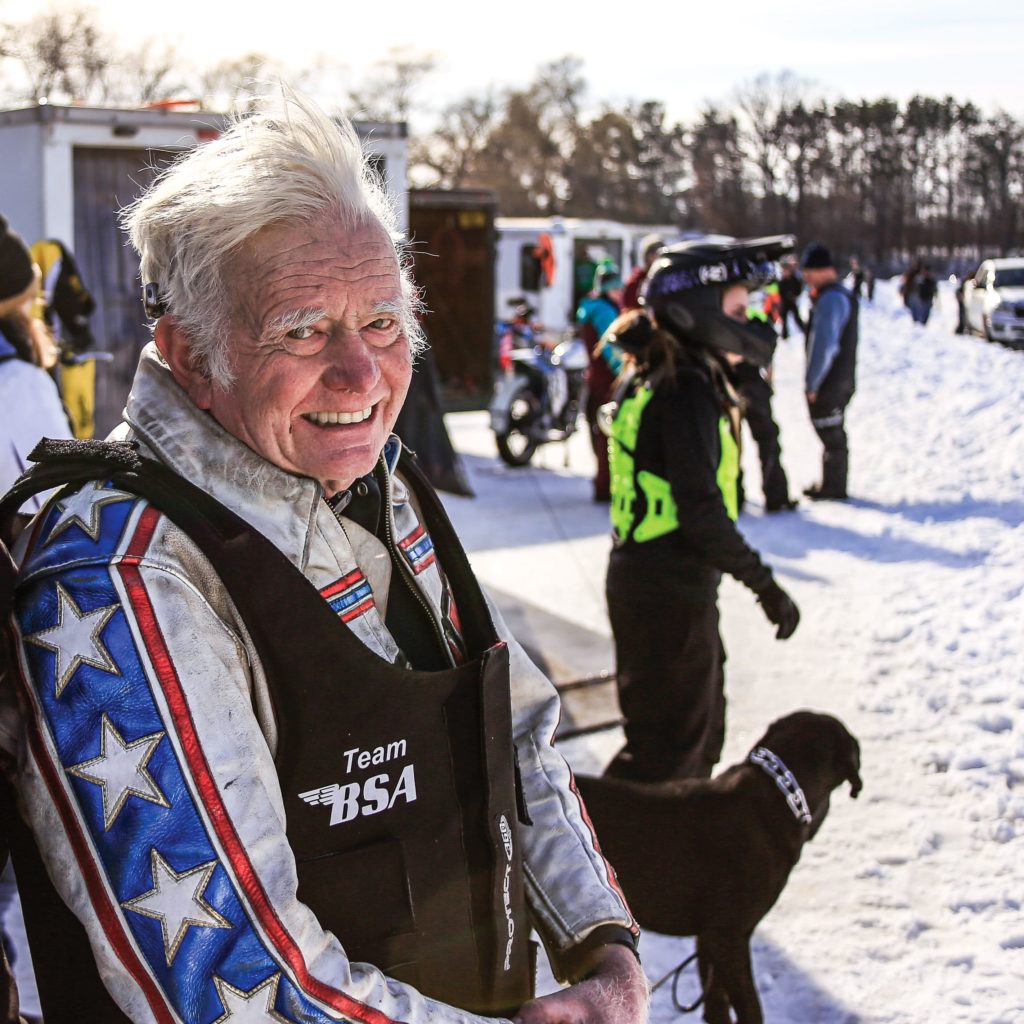
But I couldn’t leave the track without talking Chuck Dickinson, a 79-year-old racer wearing Evel Knievel leathers and riding a Suzuki 450. Despite strong tremors in his hands and a patchwork of liver spots on his head, he tore up the senior class against guys 30 years younger. He had brought his ‘favorite’ granddaughter to watch him race, while his other daughter raced in the women’s class.
“I have been on two-wheels all my life and am fortunate that I got the health to still do this,” Dickinson said. “There are others that aren’t as healthy and have to try to live with that. I am lucky … and all this is going to the great cause of cancer research.”

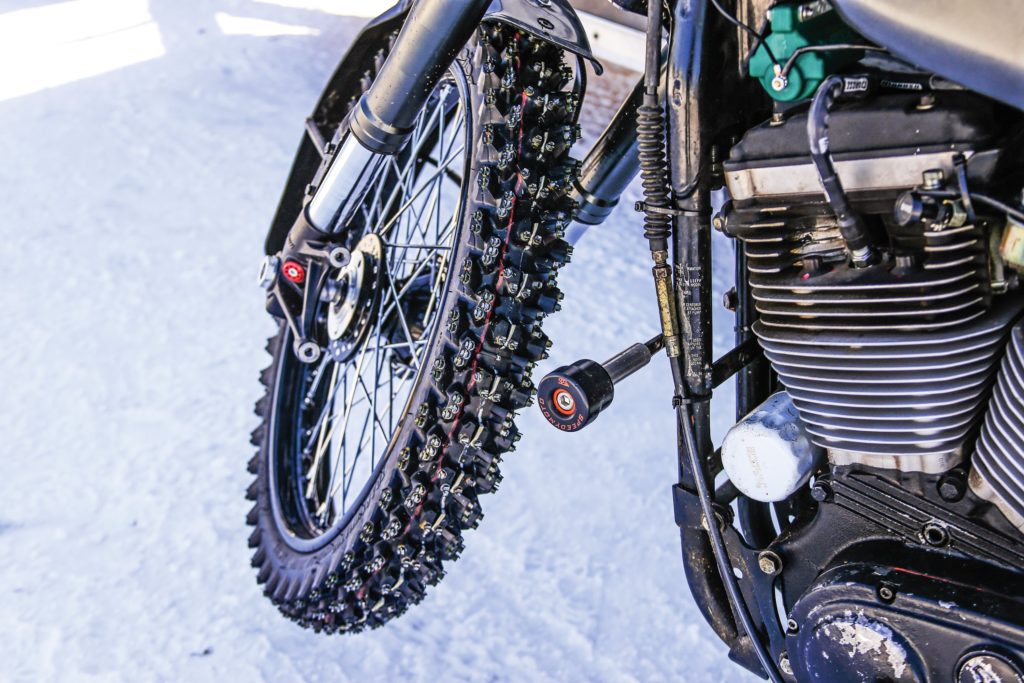
When I found Brefka later in the pits he was standing over his Harley trying to figure out why his bike didn’t shift during the race. Earlier, he had problems starting it and replaced the plugs.
“Got it! Good,” he said as the bike went in and out of gear. “Okay give me a few seconds. I have to catch my breath. My blood sugar is low.”
“Like, diabetes low? Need me to get you something to drink?” I asked.
“No, no. Not diabetes. I got a pancreas that is like a fifth the size it should be and it failed a couple months back. Imagine the nurses’ faces when I tell them ‘nope, it is cancer, not diabetes’,” he said.
Back in the early 1980s Brefka grew up watching winter ice races on Wilson Park during the annual Winter Fest. But those eventually faded until he brought them back a couple of years ago with a proposal the city jumped on. The first year the races reconvened, Brefka had an astonishing turnout of 2500 people and 70 racers.
Now, with this year being an AMA-sanctioned race, the racers came out in droves despite the numerous delays. “I never thought AMA would get involved with us,” Brefka said.
Brefka was diagnosed with pancreatic cancer five years ago. According to him, only eight percent of people diagnosed with the disease make it beyond the fifth year. All proceeds from the race go to the “We Care” fund at the Medical College of Wisconsin. The fund is part of the medical college’s surgical unit that strives for innovation and research.
“We need to increase survivability. By the numbers, it is maybe one of the worst cancers you can get. I am at year five and am going to keep having fun. I think one of the most important things maybe for any cancer patient is to stay busy. It keeps my mind active. An active mind is a happy mind,” he said.

Brefka took to the ice track on his 1982 Shovelhead, a commemorative-edition bike celebrating when the Harley folks took back the company from AMF. In fact, Brefka bought the bike in the late ‘80s from The House of Harley and it has been his daily rider ever since. He’s taken it coast to coast, put in a 93-inch Big Bore S&S Stroker, and even dragraced it on the Milwaukee mile track.
“And today, after I set it up for ice, it handled really good and went right through the ruts without a problem for a 500-pound bike,” he said.
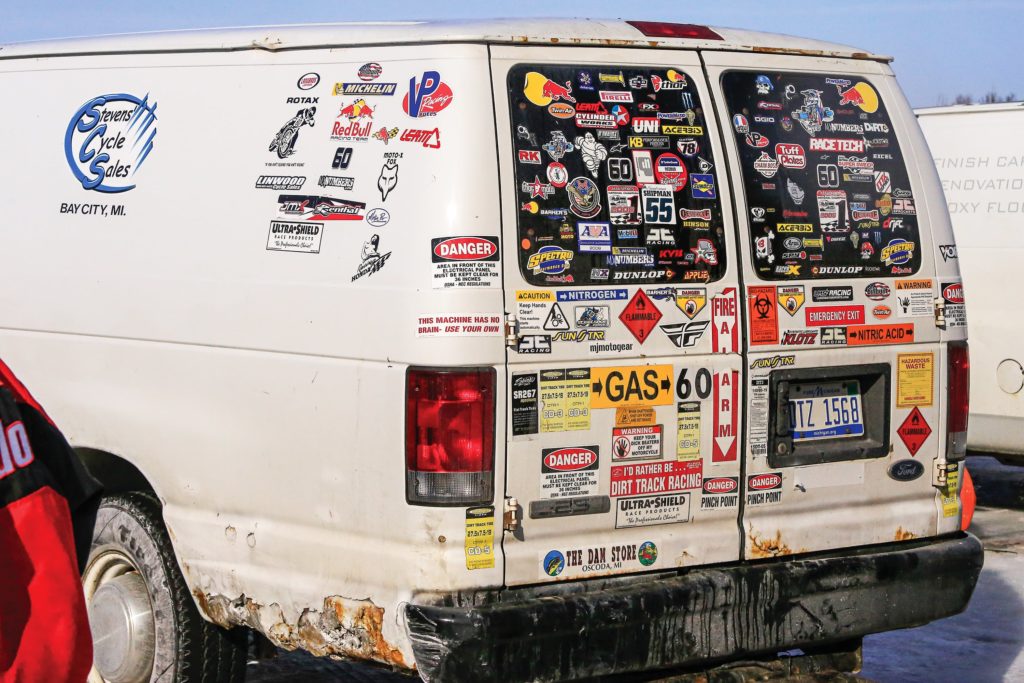
Eric Schuelke, from the greater Milwaukee area, raced his 1996 Hooligan Sportster that he built in his garage. He’s only been racing about a year after seeing flat track races at the annual Mama Tried show. While he kicked back a cold one in the pits next to his father (who was also his mechanic) I decided not to ask him about how he crashed in turn two during the practice run, sliding ass first into the snowbank and leaving pieces of metal on the track.
“Ice…it is like you have twice as much traction,” he said. “You are kind of Velcroed to it and you can lean into a turn twice as far and throttle out more to send the bike into a controlled spin. Whereas on dirt you have to play the slide out to a different level. But hell, coming from Wisconsin, ice racing is one of the reasons I got into racing.”

There was still plenty of racing going on by the time dusk started to settle in and the slushy puddles around the bikes started to freeze again. I was thankful that Brefka reminded me to wear my crampons, unlike one lady that appeared to get a wicked tailbone-bruiser down by the concessions stand.
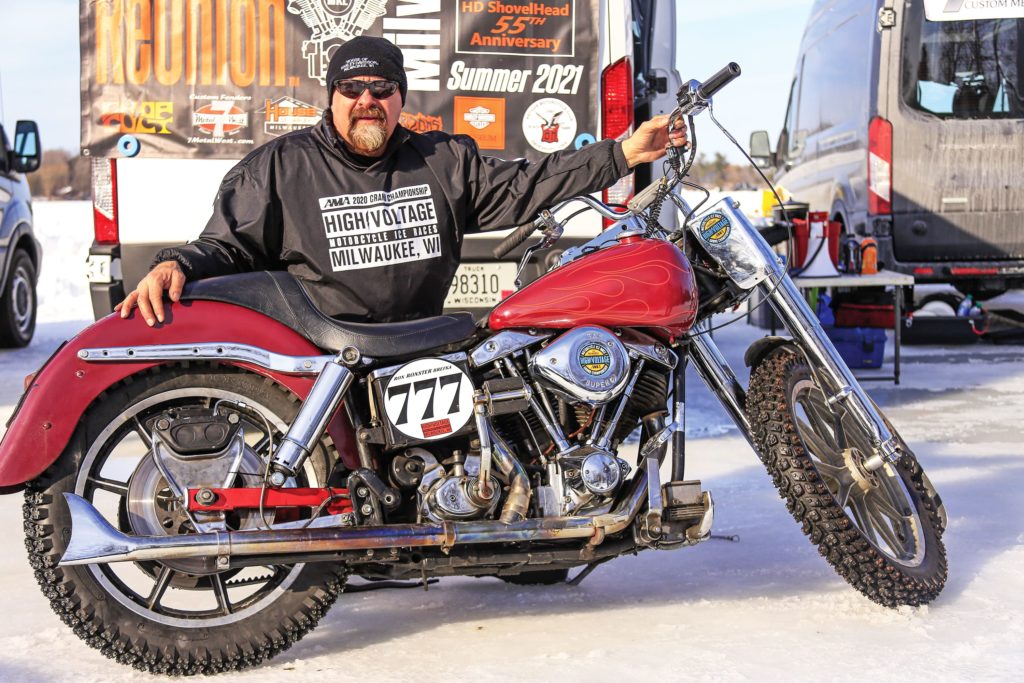
As I was heading out I caught up to Brefka while he was organizing 450cc-class riders behind the starting line, and then, once the flag fell, waiting for his last race of the day in the hooligan class finals. He was confident that with new plugs and his bike shifting right, his chances were good.
“As a cancer patient, I can attest to the fact that having fun is really important,” he told me. “You got to have something to get you out of that thought process and just have some fun.”
Well said.



